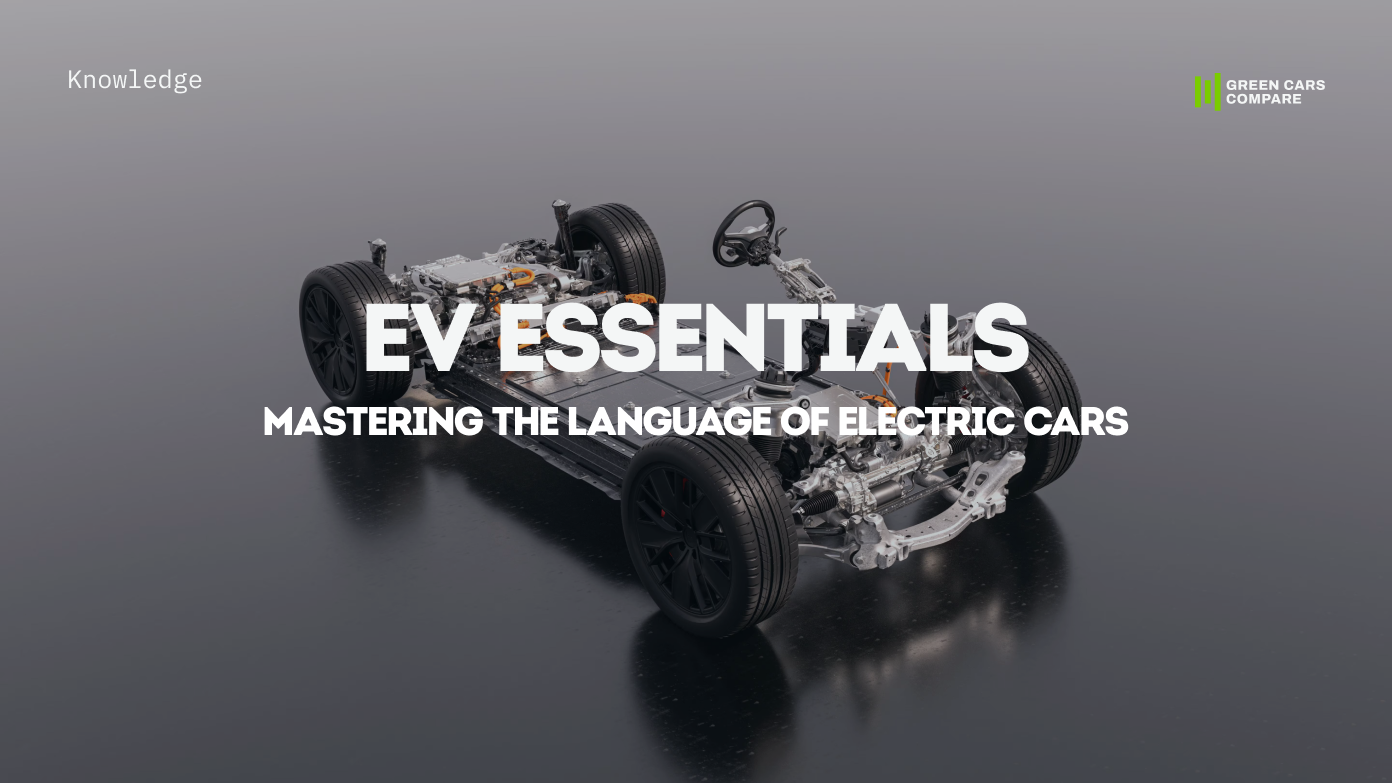EV Essentials: Mastering the Language of Electric Cars

The world is shifting gears towards sustainable transportation, and electric vehicles (EVs) are leading the charge. Yet, for many, the technology behind EVs remains a mystery. This article aims to help you navigate the evolving landscape of electric cars so that you can make decisions when choosing your first electric companion.
Table of Contents
Different Types of Electric Cars
Electric cars come in different types. Each type of EV has its own advantages and is suited to different driving needs and environments. BEVs are ideal for those looking for a fully electric solution with zero emissions, PHEVs offer flexibility for longer trips without the range anxiety, and HEVs provide improved fuel efficiency without the need for external charging.
Battery Electric Vehicles (BEVs)
BEVs, also known as all-electric vehicles or pure electric vehicles, run entirely on electricity stored in batteries.
- Power Source: Electric motor(s) powered by a large battery.
- Charging: Requires external charging via AC or DC charging stations or home outlets.
- Emissions: Zero tailpipe emissions during operation.
- Range: Range varies based on battery capacity. Typically 150–400 miles (250–650 km) per charge.
Here at Green Cars Compare, we are featuring BEVs as they offer the most significant environmental benefits by eliminating tailpipe emissions. While PHEVs and HEVs are important steps towards electrification, BEVs represent the future of clean transportation.
Plug-in Hybrid Electric Vehicles (PHEVs)
PHEVs have both an internal combustion engine (ICE) and an electric motor with a battery that can be recharged by plugging into an external source.
- Power Source: Combination of ICE and battery-powered electric motor.
- Charging: Can be charged via AC charging stations or home outlets. Also recharges through regenerative braking and by the gasoline engine acting as a generator.
- Emissions: Lower emissions than traditional ICE vehicles, especially when running on electricity.
- Range: Electric-only range typically between 20 to 50 miles (at slower speeds). Combined range (electric + gas) can exceed 500 miles.
Hybrid Electric Vehicles (HEVs)
HEVs, also known as mild hybdrids, combine an internal combustion engine with an electric motor but cannot be plugged in to recharge the battery.
- Power Source: Primarily ICE with assistance fr om the electric motor.
- Charging: No external charging. Battery is charged by the ICE and regenerative braking.
- Emissions: Lower emissions compared to traditional ICE vehicles, but higher than BEVs and PHEVs.
- Range: Typically has a range comparable to conventional vehicles, as it primarily relies on the ICE. Cannot be driven in electric-only mode.
Zero Emission Vehicles (ZEVs)
ZEVs are a broader category that includes any vehicle that emits no tailpipe pollutants. This category encompasses BEVs, hydrogen fuel cell vehicles (FCEVs), and other technologies that produce zero emissions during operation. ZEVs play a critical role in reducing air pollution and mitigating climate change by eliminating exhaust emissions. Governments and regulatory bodies often set specific targets and incentives to promote the adoption of ZEVs, aiming to accelerate the transition to cleaner transportation. Examples include California’s ZEV mandate and the European Union’s emission standards.
EV Technology Basics
The classic rumble of gasoline engines has defined cars for generations, but electric vehicles (EVs) are changing the game. These silent machines offer a whole new way to drive, marked by efficiency and sustainability. Let's explore the innovative technology behind them.
An EV relies on a well-coordinated team of components. Each of these components plays a critical role in the operation of an electric vehicle, contributing to its efficiency, performance, and environmental benefits.
Electric Motor(s)
The muscles of an EV, electric motors silently transform electrical energy into mechanical energy to propel the vehicle. They are highly efficient, providing immediate torque and smooth acceleration. During braking, they act as generators, capturing the vehicle's kinetic energy and converting it back into electricity to recharge the battery pack, extending the vehicle's range. All-wheel drive electric vehicles can have multiple electric motors, one for each axle, enhancing performance and traction.
Battery Pack
The EV's energy reservoir, akin to a fuel tank in conventional vehicles, uses advanced lithium-ion technology to store large amounts of electrical energy. These battery packs are composed of numerous small battery cells, arranged to provide the necessary voltage and capacity. Battery technology is continually advancing, improving energy density, charging speed, and longevity.
Electronic Control Units (ECUs)
Acting as the EV's central nervous system, ECUs manage and coordinate various functions of the vehicle. Modern EVs can have dozens of ECUs working together seamlessly to regulate thermal management of the battery pack, control the output of the electric motor(s), oversee regenerative braking, and ensure the operation of safety systems like traction control and stability management.
Charging System
Serving as the EV's lifeline, the charging system connects the vehicle to the electricity grid. It includes both the hardware and software necessary for recharging the battery pack, whether through a regular domestic outlet, or public charging stations (AC or DC). Efficient charging systems are crucial for extending the vehicle's range and ensuring convenience for the driver.
Electricity Basics
Understanding electricity is simpler than it seems. Here’s a quick guide using a water analogy.
Flow of Electricity
- Electricity is the flow of electrons fr om one source to another.
- Cables and wires act like hoses for electrons.
- Charging an EV is similar to filling a bucket with water using a hose. The charger (faucet) controls the flow of electrons through the cable (hose) to the EV’s battery (bucket).
Volts (V)
- Voltage (V) measures the pressure pushing electrons through a wire.
- Higher voltage means faster electron flow, like higher water pressure.
- The European Advantage: Many European countries utilize three-phase power, which can further accelerate charging compared to single-phase systems commonly found in North America.
- Example: Level 1 chargers operate at 110V (230V in the EU), while Level 2 chargers operate at 240V (400V 3-phase current in the EU). Modern EVs typically use a 400V system, with some like the Hyundai Ioniq 5 N using 800V for faster charging.
Amps (A)
- Amperage (A) measure the flow rate of electrons.
- Higher amperage means more electrons flowing through a wire, like faster water flow through a hose.
- Example: Home circuit breakers show amperage (e.g., 10A, 20A). Higher amperage chargers (e.g., 48A) charge EV batteries faster than lower amperage chargers (e.g., 10A).
Kilowatt (kW)
- Watt (W) measures electrical power; a kilowatt (kW) is 1,000 watts.
- Higher power (kW) means more energy flow, like water exiting a hose with more force.
- Example: EV motor power is often expressed in kW (e.g., 125 kW is equivalent to 167 horsepower). Charging rates also use kW (e.g., a Tesla Model S Plaid has a peak DC charging rate of 250 kW).
Kilowatt-hour (kWh)
- Kilowatt-hour (kWh) measures stored electrical energy.
- kWh is to EVs what gallons are to gasoline vehicles. When charging, you'll see the amount of kWh delivered, similar to refueling with gasoline. This helps you understand how much energy has been added to your EV’s battery.
- Example: EVs like the Tesla Cybertruck AWD have large batteries (123 kWh) compared to smaller ones in plug-in hybrids (e.g., Hyundai Tucson PHEV with 13.8 kWh).
EV Charging Basics
Charging your electric vehicle (EV) can be done through different methods, each with varying speeds and requirements. Here's a breakdown of the basics of EV charging:
Level 1 AC Charging
- Definition: Level 1 AC charging uses a standard household outlet to charge your EV.
- Voltage: Operates at 110V in the USA (230V in the EU).
- Charging Speed: Provides around 5-8 miles (10-12 km) of range per hour of charging.
- Use Case: Suitable for overnight charging or for drivers with low daily mileage needs.
- On-Board Charger: The EV’s on-board charger converts AC power fr om the outlet to DC power to charge the battery. Most modern on-board chargers can easily handle Level 1 charging without limiting power.
Level 2 AC Charging
- Definition: Level 2 AC charging uses a dedicated charging station, often installed at home or found at public charging locations.
- Voltage: Operates at 240V in the USA (400V 3-phase in the EU).
- Charging Speed: Provides around 15-60 miles (25-100 km) of range per hour of charging, depending on the vehicle and the on-board charger’s capacity.
- Use Case: Ideal for home charging, workplaces, and public locations wh ere vehicles can be parked for several hours.
- On-Board Charger: Similar to Level 1, the on-board charger converts AC power to DC, but at a faster rate due to higher voltage and amperage. The capacity of the on-board charger can lim it the charging speed.
Level 3 DC Fast Charging
- Definition: Level 3 DC fast charging uses high-power DC chargers typically found at public charging stations along highways and major routes.
- Voltage: Operates at 400V or 800V.
- Charging Speed: Provides around 3-20 miles (5-30 km) of range per minute, depending on the charger and the vehicle’s DC charging capability.
- Use Case: Best for long trips or quick top-ups when time is limited. While convenient, frequent DC charging can shorten your battery's lifespan. It's best used for public charging on the go, not as your primary charging solution.
- Charging Speed: Unlike AC charging, DC fast chargers deliver power directly to the battery, bypassing the on-board charger. However, it's important to note that the battery's DC charging capability can lim it the charging speed. An old vehicle with a lower-capacity battery may not be able to accept as much power as a modern vehicle with a higher-capacity battery or more advanced charging technology (e.g., 800V architecture).
Understanding these charging methods helps you optimize your EV's charging routine, ensuring that you have the power you need when you need it.
If you want to learn more about EV Charging, check this article.
Efficiency: The Key to Maximizing Range
Every EV driver wants to maximize range, and efficiency is key. It’s about how well your car converts battery energy into movement. EVs are highly efficient, converting over 80% of grid-supplied electricity into power for the wheels, compared to gasoline vehicles, which typically achieve only about 20–30% efficiency in terms of energy conversion from fuel to motion.
EV efficiency is measured in kilowatt-hours per 100 miles (or kilometers), with lower numbers indicating greater efficiency. The average BEV efficiency typically falls within the range of 25 to 35 kWh per 100 miles (15–22 kWh per 100 km).
Factors Affecting Efficiency
Several factors influence an EV's efficiency:
- Aerodynamics: The design of the vehicle affects how it cuts through the air. Sleeker designs with lower drag coefficients improve efficiency by reducing air resistance.
- Weight: Heavier vehicles require more energy to move. While battery packs add weight, manufacturers use lightweight materials to mitigate this effect.
- Battery Technology: The type and quality of the battery impact efficiency. Advanced battery chemistries and improved energy densities can enhance efficiency.
- Tire Resistance: Low rolling resistance tires designed for EVs can reduce energy consumption. Proper tire maintenance, such as correct inflation, also plays a role.
- Driving Habits: Aggressive driving with rapid acceleration and braking consumes more energy. Smooth and steady driving optimizes efficiency.
- Regenerative Braking: Efficient use of regenerative braking, which recaptures energy during braking and feeds it back to the battery, can improve overall efficiency.
- Climate Control Systems: Using air conditioning or heating can significantly impact efficiency. EVs use electricity for climate control, which can drain the battery more quickly.
- Terrain and Road Conditions: Driving on hilly or rough terrain requires more energy compared to flat, smooth roads.
- Speed: Higher speeds increase aerodynamic drag exponentially, leading to higher energy consumption. EVs are more efficient at moderate, steady speeds.
- Temperature: Batteries operate optimally within a specific temperature range, and extreme cold or hot temperatures require additional energy for heating or cooling the battery pack.
Factors such as driving habits, speed, and use of climate control systems are within the driver's control and can significantly impact efficiency. However, factors like aerodynamics, battery technology, and vehicle weight are are determined by the vehicle's design and technology.
Understanding EV Range: EPA, WLTP, and NEDC
When evaluating an EV, a crucial factor is its driving range — the estimated distance it can travel on a single charge. However, interpreting and comparing range figures can be confusing because there are different testing procedures used around the world. Here's an overview of the three most common range ratings:
- EPA (Environmental Protection Agency): The United States Environmental Protection Agency (EPA) employs a test cycle designed to simulate typical American driving conditions. This includes a mix of city and highway driving, with varying speeds, accelerations, and stop-and-go situations. The EPA range is generally considered the most conservative and realistic estimate for American drivers.
- NEDC (New European Driving Cycle): The NEDC, now replaced by the WLTP, was the previous standard for measuring EV range in Europe. It faced criticism for its overly optimistic nature, featuring a shorter test cycle and less demanding driving conditions. Consequently, NEDC range figures often exceeded both EPA and WLTP ratings.
- WLTP (Worldwide Harmonised Light Vehicles Test Procedure): Introduced in 2017 as a replacement for NEDC, the WLTP is a more rigorous test cycle adopted by the European Union and other regions. WLTP incorporates a longer test duration, higher average speeds, and more aggressive acceleration profiles compared to the NEDC. Consequently, WLTP range figures tend to be slightly lower than NEDC ratings for the same vehicle.
Conclusion
The world of electric vehicles might seem complex at first, but understanding the core concepts is easier than you think. You don't need to be an expert on every technical term. Instead, focus on comparing key specifications across different EV models.
For starters, consider the electric motor's power (kW) for acceleration and performance. Battery size (kWh) and vehicle efficiency (kWh/100 mi or 100 km) determines your range, while max charging power (kW) dictates how quickly you can replenish the battery.
Charging your EV efficiently involves matching the charging station's capabilities to your car's specifications. For DC fast charging, exceeding your vehicle's peak charging rate won't provide any additional speed benefit. Similarly, when installing a Level 2 AC home charger, ensure its amperage aligns with your car's on-board charger capacity. This way, you'll optimize charging speed and avoid unnecessary investment in a more powerful charger that your car can't utilize fully.
By familiarizing yourself with these basics, you'll be well-equipped to experience the benefits of electric vehicles with confidence. Good luck! Stay charged!





Discussion
Gasoline engines do waste a significant amount of energy as heat. This is because they have to convert chemical energy into mechanical energy.
Electric motors, on the other hand, can directly convert electrical energy into mechanical energy, which is why they are so much more efficient (90-95%).